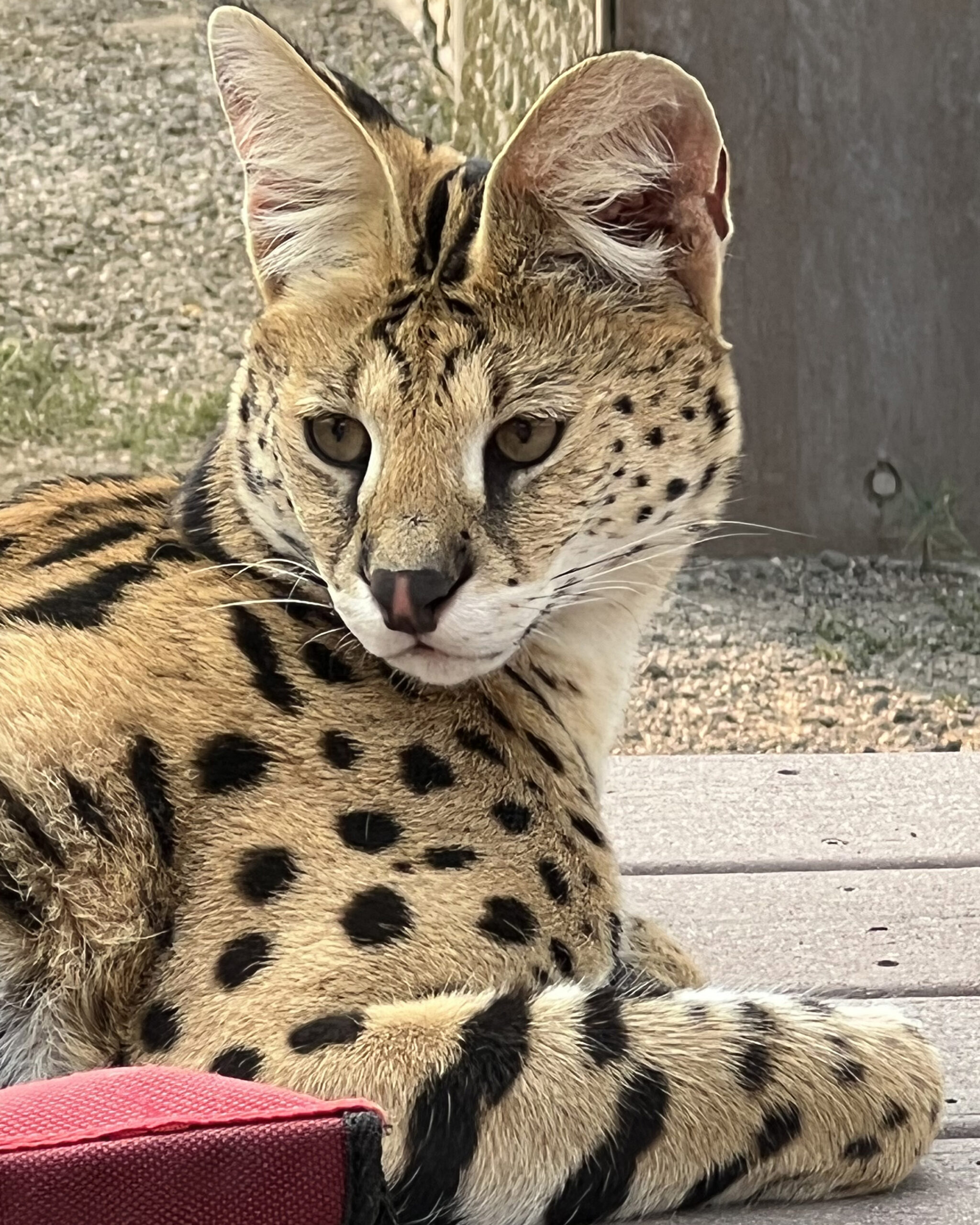Serval – Ozzy
(Leptailurus serval)
Tall, elegant, and lightning-fast, the serval is one of Africa’s most distinctive wild cats. With long legs, oversized ears, and a coat of bold black spots, servals are extraordinary hunters built for stealth and speed. At Cat Tales Wildlife Center, our resident serval Ozzy represents both the grace of his species and the complex challenges surrounding exotic pet ownership in the United States.

All About Servals
Appearance
A medium-sized African cat with the longest legs relative to body size of any feline. Their spotted, tawny coats blend perfectly with tall grasslands.
Hearing
Servals’ oversized ears allow them to detect rodents moving underground. They often hunt by sound alone.
Hunting Technique
Known for their famous “cat pounce,” servals leap up to 13 feet horizontally to strike prey with their front paws.
Diet
Carnivorous, feeding mainly on rodents, birds, frogs, and fish. They also hunt insects and occasionally wade into shallow water to catch prey.
Habitat
Found in sub-Saharan Africa, particularly in wet grasslands or near water where prey is abundant.
Reproduction
Females give birth to 1–3 kittens in dense vegetation or abandoned burrows after a gestation of about 70 days.
Servals are solitary and mostly nocturnal, traveling well-worn paths through the grass. Their combination of agility, power, and sensory precision makes them one of the most efficient hunters in the animal kingdom.
Ozzy – “The Boss”
Born April 7, 2019, Ozzy arrived at Cat Tales in December 2020 after his family made the compassionate decision to rehome him. They loved him deeply but faced changing regulations regarding serval ownership in their area. Rather than risk his confiscation or euthanasia, they placed his welfare first—entrusting him to Cat Tales for a permanent, safe, and enriching home.
Since joining the sanctuary, Ozzy has quickly earned his nickname: “The Boss.” Confident and alert, he commands attention with his tall frame and sleek, golden coat. He spends his days patrolling his habitat, listening intently for sounds, and demonstrating his remarkable jumping and hunting skills during enrichment sessions.
Despite his wild instincts, Ozzy has adapted beautifully to sanctuary life. He enjoys warm bedding in winter, a heated shelter, and plenty of stimulation from puzzle feeders, scent enrichment, and environmental changes. His story stands as a powerful example of responsible surrender and compassionate wildlife care.
Servals and their hybrid relatives—the Savannah Cats—are still legally owned as pets in some areas of the U.S., despite being wild animals by nature. As kittens, they may appear similar in size and behavior to domestic cats, but as they mature, their wild instincts and athletic energy become impossible to manage safely in a home.
- Unpredictable Behavior: Servals hunt by stunning prey with powerful paw strikes and can leap to ceiling height in a single bound. These same behaviors make them destructive and potentially dangerous indoors.
- Intense Energy: They are highly active and require vast space, mental stimulation, and specialized diets to stay healthy.
- Fear of Loud Sounds: Their exceptional hearing makes them easily startled by noise, leading to anxiety and unpredictable reactions.
- Frequent Rehoming: Many servals and hybrids are surrendered to sanctuaries each year when owners realize they cannot meet their needs or face changing ownership laws.
Cat Tales provides lifelong sanctuary for animals like Ozzy—offering them a natural environment, proper care, and the opportunity to educate the public about responsible wildlife respect.
In the wild, servals are listed as a species of Least Concern, though they face ongoing threats from habitat loss, hunting, and capture for the pet trade. Their beauty has unfortunately made them a target for exotic ownership and the fashion industry.
At Cat Tales, Ozzy helps visitors understand that wild animals belong in the wild—and that ethical sanctuaries play a vital role in offering lifelong refuge to animals who can no longer live there. By learning from him, guests gain insight into the importance of conservation through compassion.
Ozzy’s habitat is designed to reflect his natural environment, giving him space to move, observe, and rest comfortably.
- Enrichment: Hidden treats, climbing platforms, and new scents encourage Ozzy’s natural curiosity and athleticism.
- Care: Keepers monitor his diet, behavior, and seasonal coat changes, ensuring he remains healthy and active year-round.
- Ambassador Role: Ozzy helps educate guests about the realities of exotic animal ownership and the need for ethical wildlife practices.
His confident demeanor and alert posture make him a visitor favorite—and a shining example of how care and respect can restore dignity to animals once caught between wild and domestic worlds.
Education
Ozzy’s story provides a real-world lesson on why wild animals do not make suitable pets and how laws protecting them benefit both animals and people.
Advocacy
He represents the success of sanctuary care—showing how responsible decisions can lead to lifelong safety and educational impact.
Research & Welfare
Observing Ozzy’s behavior helps improve enrichment and care standards for servals and similar species in captivity.


